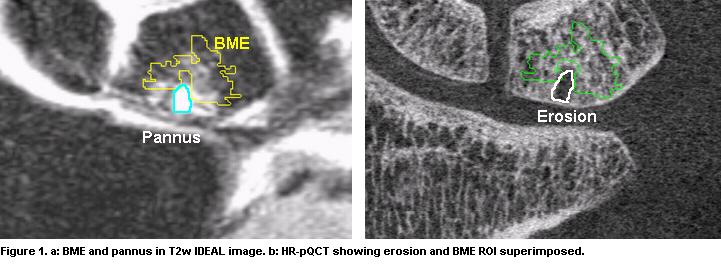Session Information
Session Type: Abstract Submissions (ACR)
Background/Purpose:
Bone marrow edema (BME) has been suggested as a strong predictor for erosive progression in RA joints, however, no previous studies examined the bone structure within BME. This study aimed to quantify bone structure and perfusion properties of BME, normal bone marrow (NBM) and pannus tissue areas in wrists affected by RA using 3T MRI and high resolution peripheral quantitative CT (HR-pQCT).
Methods:
Sixteen patients (52.9 ± 12.7 years) fulfilling ACR classification were imaged in a HR-pQCT system (82µm isotropic voxel) and in a 3T MRI scanner using an 8-channel wrist coil. Coronal T2-weighted fast spin-echo IDEAL and 3D dynamic contrast enhanced (Gd-DTPA injection, temporal resolution 12 s, 32 time points) images were acquired. BME and pannus tissue areas were segmented semi-automatically in T2-w images. NBM areas were placed 1 to 3 mm far from BME regions and with similar distance to joint space. T2-w images were register to reformatted HR-pQCT and registration was applied to the segmented ROIs that were placed on original HR-pQCT images after upsampling (Fig 1). Perfusion parameters were calculated based on the signal-time curve obtained from DCE-MRI.
Results:
Eleven out of 16 RA patients presented at least one BME region. Eighteen BME areas were segmented, 13 of them were presented around areas evidently affected by pannus tissue. The regions with pannus tissue in MRI always correspond to regions with erosion in HR-pQCT images (Fig 1). Two BME areas were presented next to early stage of pannus tissue (very small quantity of pannus penetrating the bone). For 3 of the BME regions, no pannus tissue were observed. Significant increases in bone density and trabecular thickness were evidenced in all BME regions (Fig 2).
BME and pannus tissue areas show significantly increased perfusion. The maximum signal enhancement in BME was 20.33 ± 14.33 (% over NBM) within the carpal bones and 21.32 ± 10.52 within the distal radius/ulna. In pannus tissue areas was 16.48 ± 11.34 (% over NBM) within the carpal bones and 32.93 ± 16.71 within the radius/ulna.
Conclusion:
BME regions show a thickening in the trabecular structure that suggests a bone regeneration before pannus tissue produces erosion. Trabecular thickening within BME is higher when pannus tissue is already presented in the patient. This higher thickening suggests sclerosis occurring to protect the bone structure from pannus tissue and kinematic re-adaptation. Combining MRI and HR-pQCT provides a powerful multi-modality approach for better understanding BME and erosion, and potentially identifying novel imaging markers for disease progression in RA.
Disclosure:
J. R. Teruel Antolin,
None;
A. J. Burghardt,
None;
J. Rivoire,
None;
W. Srikhum,
None;
S. M. Noworolski,
None;
T. M. Link,
None;
J. B. Imboden,
None;
X. Li,
None.
« Back to 2012 ACR/ARHP Annual Meeting
ACR Meeting Abstracts - https://acrabstracts.org/abstract/bone-structure-and-perfusion-quantification-of-bone-marrow-edema-and-pannus-tissue-areas-in-the-wrist-of-patients-with-ra/


